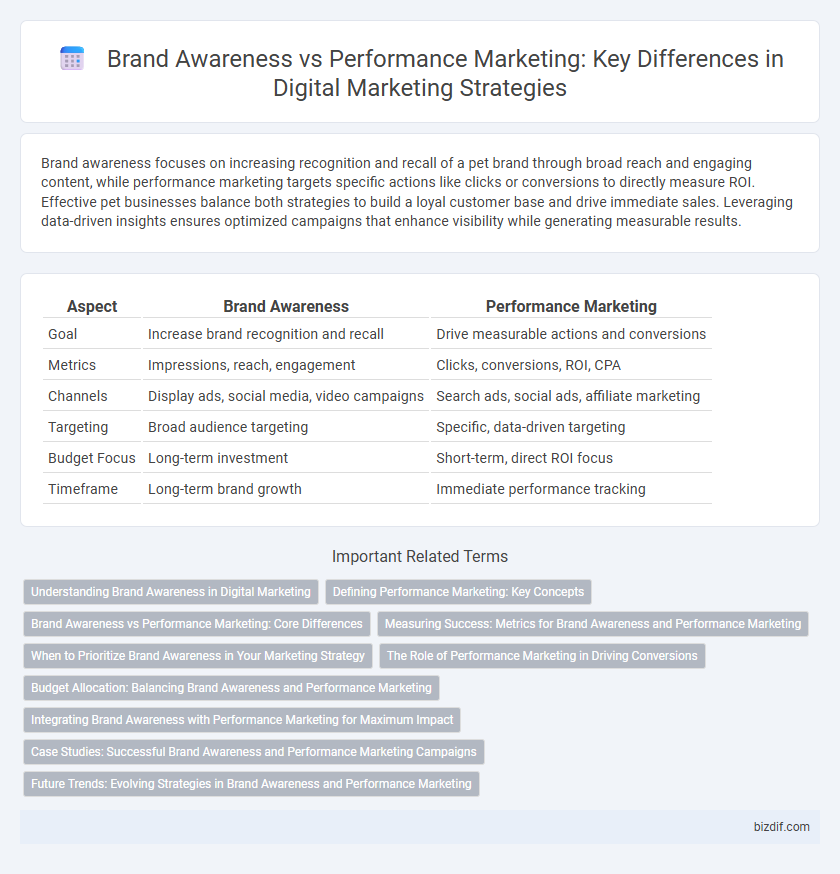Brand awareness focuses on increasing recognition and recall of a pet brand through broad reach and engaging content, while performance marketing targets specific actions like clicks or conversions to directly measure ROI. Effective pet businesses balance both strategies to build a loyal customer base and drive immediate sales. Leveraging data-driven insights ensures optimized campaigns that enhance visibility while generating measurable results.
Table of Comparison
| Aspect | Brand Awareness | Performance Marketing |
|---|---|---|
| Goal | Increase brand recognition and recall | Drive measurable actions and conversions |
| Metrics | Impressions, reach, engagement | Clicks, conversions, ROI, CPA |
| Channels | Display ads, social media, video campaigns | Search ads, social ads, affiliate marketing |
| Targeting | Broad audience targeting | Specific, data-driven targeting |
| Budget Focus | Long-term investment | Short-term, direct ROI focus |
| Timeframe | Long-term brand growth | Immediate performance tracking |
Understanding Brand Awareness in Digital Marketing
Brand awareness in digital marketing measures how familiar consumers are with a brand, influencing their likelihood to consider and choose it over competitors. Key metrics include reach, impressions, and engagement rates across channels such as social media, display ads, and content marketing. Building strong brand awareness establishes long-term customer loyalty and supports future performance marketing efforts by creating a recognizable and trusted presence online.
Defining Performance Marketing: Key Concepts
Performance marketing centers on measurable actions such as clicks, leads, and conversions, enabling precise return on investment (ROI) tracking through analytics and data-driven strategies. Unlike brand awareness campaigns that prioritize visibility and recognition, performance marketing emphasizes direct response and optimized targeting to drive immediate results. Key concepts include pay-per-click (PPC), affiliate marketing, conversion rate optimization (CRO), and real-time performance monitoring to maximize efficiency and profitability.
Brand Awareness vs Performance Marketing: Core Differences
Brand awareness marketing aims to increase a target audience's recognition and recall of a brand through broad-reach campaigns, often using metrics like impressions and engagement rates to measure success. Performance marketing focuses on driving specific actions such as clicks, leads, or sales, relying heavily on data analytics and ROI tracking to optimize campaigns. Understanding the core differences involves recognizing brand awareness as a long-term strategy focused on building brand equity, while performance marketing delivers direct, measurable results to fuel short-term growth.
Measuring Success: Metrics for Brand Awareness and Performance Marketing
Brand awareness is measured through metrics such as reach, impressions, brand recall, and social media engagement, which assess the extent of audience exposure and recognition. Performance marketing focuses on quantifiable results including click-through rates (CTR), conversion rates, cost per acquisition (CPA), and return on ad spend (ROAS) to evaluate campaign efficiency. Understanding these distinct metrics enables marketers to tailor strategies that balance long-term brand growth with immediate performance goals.
When to Prioritize Brand Awareness in Your Marketing Strategy
Prioritize brand awareness in your marketing strategy when launching new products, entering untapped markets, or building long-term customer loyalty. Brand awareness campaigns enhance recognition and trust, which create a foundation for future performance marketing success. Investing in brand visibility before aggressive conversion tactics ensures a more engaged and receptive target audience.
The Role of Performance Marketing in Driving Conversions
Performance marketing plays a critical role in driving conversions by leveraging data-driven strategies such as pay-per-click (PPC), affiliate marketing, and targeted social media ads to optimize campaign ROI. Unlike brand awareness campaigns that focus on long-term visibility, performance marketing directly tracks consumer actions like clicks, leads, and sales, enabling precise measurement and rapid adjustment. Utilizing tools like Google Analytics and conversion tracking, marketers can efficiently allocate budgets towards high-performing channels that maximize customer acquisition and revenue growth.
Budget Allocation: Balancing Brand Awareness and Performance Marketing
Effective budget allocation in digital marketing hinges on balancing brand awareness and performance marketing to maximize ROI. Investing in brand awareness campaigns builds long-term customer recognition and loyalty, while performance marketing drives immediate conversions through targeted ads and measurable actions. Allocating budget based on campaign goals, audience insights, and sales funnel stages ensures optimal use of resources for both brand equity and direct response outcomes.
Integrating Brand Awareness with Performance Marketing for Maximum Impact
Integrating brand awareness with performance marketing enhances customer engagement by combining emotional connection and data-driven optimization. Leveraging brand awareness increases trust and recall, which improves conversion rates in performance campaigns through targeted ads and measurable metrics. This synergy amplifies marketing ROI by balancing long-term brand equity cultivation with immediate performance results.
Case Studies: Successful Brand Awareness and Performance Marketing Campaigns
Case studies of successful campaigns reveal that brand awareness strategies often leverage emotional storytelling and wide-reaching platforms to build long-term consumer loyalty, exemplified by Nike's "Just Do It" series which increased brand recall by 31%. Performance marketing campaigns focus on direct response and measurable results, such as Airbnb's targeted social media ads that delivered a 20% uplift in bookings within three months through precise audience segmentation and retargeting. Combining insights from both approaches allows marketers to optimize budget allocation and enhance overall ROI by balancing brand growth with actionable conversions.
Future Trends: Evolving Strategies in Brand Awareness and Performance Marketing
Future trends in digital marketing emphasize the integration of brand awareness and performance marketing through data-driven strategies and AI-powered personalization. Marketers increasingly leverage real-time analytics and customer journey mapping to optimize campaigns that enhance both brand equity and conversion rates. Emerging technologies such as augmented reality and interactive content are reshaping engagement, driving more immersive experiences that align long-term brand value with immediate performance goals.
Brand awareness vs performance marketing Infographic

 bizdif.com
bizdif.com